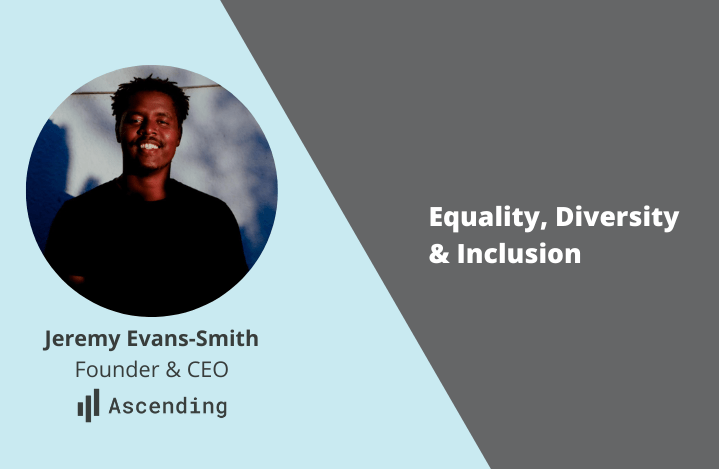Jennifer Gaster spoke with Jeremy Evans-Smith, Founder and CEO of Ascending about Equality, Diversity and Inclusion
How did your career begin?
I’m originally from West Michigan, in the US, but about six years ago I branched out and moved to New York City.
While working in Manhattan, I stumbled upon the startup industry and within a year moved to Berkeley, near Silicon Valley, the “birthplace of tech.”
Since moving, I’ve found my fit helping startups elevate their equity, diversity and inclusion recruiting efforts.
I’ve been fortunate enough to work in EDI for the past eight years, beginning with higher education work. After moving to California, I got my foot in the door at Google in their Recruiting-People Ops department. From there, I’ve worked with several VC-backed startups, which eventually led to my current work founding Ascending, the EDI-Analytics tool for forward-thinking teams.
Why are you passionate about ED&I and how did you get to be working in that field?
The leading reason for my passion in Equality, Diversity & Inclusion work is gratitude.
My career success is a direct product of others having created opportunities for me to access pathways that I was ready to engage with, but might not have been on my radar.
My personal conviction is that EDI work is about creating awareness and intentionally building bridges to people who might not be aware of the opportunities available to them.
In your opinion, what is wrong with the way businesses tackle ED&I currently?
My response is a bit of a contrarian belief, but I believe businesses, and the people that lead them, fail at EDI because their “commitments” or statements of solidarity are not genuine reflections of their personal lives.
Executives fail to have authentic friendships with the demographics they seek to support; or they cannot contextualise their peers or direct reports’ experiences.
How do you approach it?
Fortunately, I’m a Black American man. This allows me an especially unique and valuable lived experience – although not a “pass.”
For instance, my intersectional experience is different from a Black or indigenous, transgender, female or gender-non-binary identifying person.
As a consequence, I really try to approach EDI work from a posture of listening and believing. And this listening ethic is the foundation of Ascending’s software, which exists to safely amplify the voices of employees – especially those who have been historically marginalised or underrepresented.
Going a bit deeper into our approach, once we gather the data from amplifying the qualitative sentiments of employees, we then quantify to give teams an EDI score.
Ascending then enhances score accuracy with API integrations (eg: HRIS; ATS) that creates an extremely accurate benchmark; from here we give teams personalised recommendations for improvement and help implement that through various learning avenues.
What should businesses be assessing and measuring in Equality Diversity & Inclusion?
There are many things businesses should be assessing.
Here are a few that can be considered “the basics”:
Diversity (internal representation, recruiting funnel, retention/attrition) Equity (compensation rates and promotion rates) and Inclusion (employee sentiment and experience.)
It requires a lot of work.
I know from first-hand experience when I used to track spreadsheets with my team and manually slog through data from surveys and Applicant Tracking Systems (or ATS.) Even though it’s worth it, it’s usually no fun.
That’s part of the reason why we created Ascending and made it free for small-to-medium sized businesses up to 100 employees.
We believe fostering confidence in your team’s EDI should be simple.


